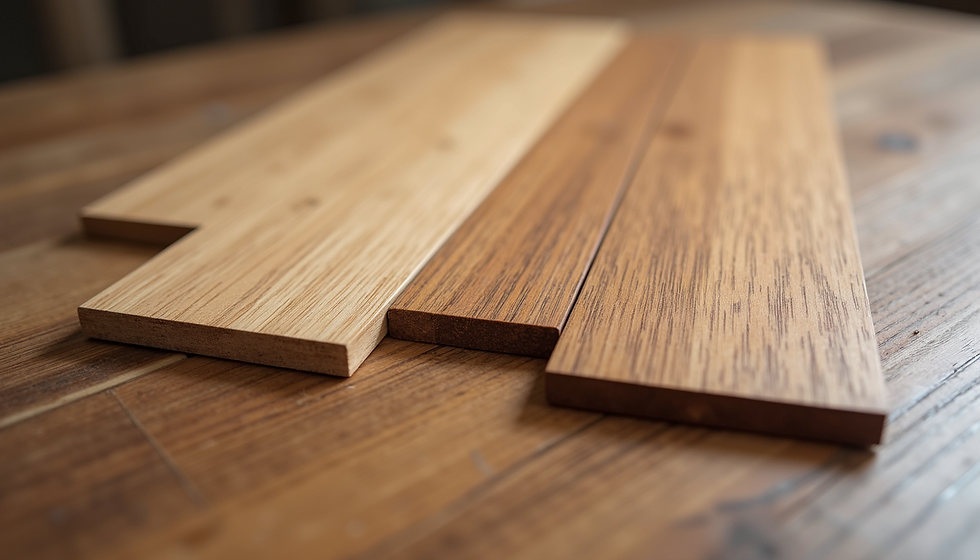Expert Tips for Refinishing Hardwood Floors
- Peyton Moffitt
- Oct 6
- 3 min read
Refinishing wood floors can breathe new life into your home, restoring the natural beauty and warmth of hardwood. Whether your floors are scratched, dull, or stained, refinishing is a cost-effective way to make them look brand new. This guide will walk you through expert tips and practical advice to help you achieve stunning results.
Understanding the Basics of Refinishing Wood Floors
Refinishing wood floors involves sanding down the surface to remove the old finish and imperfections, then applying a new finish to protect and enhance the wood. This process can dramatically improve the appearance of your floors and increase the value of your home.
Why Refinish Your Wood Floors?
Restore beauty: Over time, hardwood floors can lose their shine and develop scratches or dents.
Increase durability: A fresh finish protects the wood from moisture, dirt, and wear.
Cost-effective upgrade: Refinishing is often less expensive than replacing floors.
Customize appearance: You can change the stain color or finish type to match your decor.
Types of Finishes
Choosing the right finish is crucial for durability and appearance. Common options include:
Polyurethane: Durable and water-resistant, available in oil-based or water-based formulas.
Wax: Traditional finish that offers a soft sheen but requires more maintenance.
Penetrating oil: Enhances natural grain but offers less protection.

Essential Tips for Refinishing Wood Floors
Refinishing wood floors requires careful preparation and attention to detail. Here are some expert tips to ensure a smooth and successful project:
1. Prepare the Room Properly
Remove all furniture and rugs.
Seal off doorways and vents to minimize dust spread.
Clean the floor thoroughly to remove dirt and debris.
2. Choose the Right Sandpaper Grit
Start with a coarse grit (around 36-40) to remove old finish and scratches. Progress to medium (60-80) and finish with fine grit (100-120) for a smooth surface.
3. Use the Proper Sanding Equipment
Rent or buy a drum sander for large areas and an edge sander for corners and edges. Always sand in the direction of the wood grain to avoid scratches.
4. Remove Dust Thoroughly
After sanding, vacuum and wipe the floor with a damp cloth to remove all dust. Dust can ruin the finish if not completely removed.
5. Apply Finish Evenly
Use a high-quality brush or applicator. Apply thin, even coats and allow proper drying time between coats. Lightly sand between coats for a smooth finish.

Can I refinish a hardwood floor myself?
Many homeowners consider DIY refinishing to save money. While it is possible, it requires patience, the right tools, and some skill.
Pros of DIY Refinishing
Cost savings on labor.
Flexibility to work on your own schedule.
Satisfaction of completing a home improvement project.
Cons of DIY Refinishing
Time-consuming and physically demanding.
Risk of damaging floors if sanding is uneven.
Potential for dust and fumes in your home.
Requires renting or purchasing specialized equipment.
Tips for DIY Success
Watch tutorial videos and read guides carefully.
Practice sanding on a small, inconspicuous area first.
Rent quality equipment and ensure proper ventilation.
Take your time and do not rush the process.
If you feel unsure, hiring a professional can save time and ensure a flawless finish.

Maintaining Your Newly Refinished Floors
Once your floors are refinished, proper care will keep them looking beautiful for years.
Daily Care
Sweep or vacuum regularly to remove dirt and grit.
Use a damp mop with a cleaner designed for hardwood floors.
Avoid excessive water which can damage wood.
Preventative Measures
Use felt pads under furniture legs.
Place rugs in high-traffic areas.
Avoid walking on floors with high heels or cleats.
Periodic Maintenance
Reapply finish every few years depending on wear.
Address scratches promptly with touch-up kits.
When to Call a Professional
While DIY refinishing is an option, some situations call for professional expertise:
Floors with deep gouges or water damage.
Large areas requiring extensive sanding.
Historic or exotic wood species needing special care.
Desire for custom stains or finishes.
Professional services can provide expert sanding, staining, and finishing with minimal disruption. For reliable and high-quality hardwood floor refinishing, consider contacting experienced specialists.
Refinishing wood floors is a rewarding project that can transform your living space. With the right preparation, tools, and techniques, you can restore your floors to their original beauty or even create a new look. Whether you choose to tackle the job yourself or hire a professional, these expert tips will help you achieve stunning results that last.





Comments